
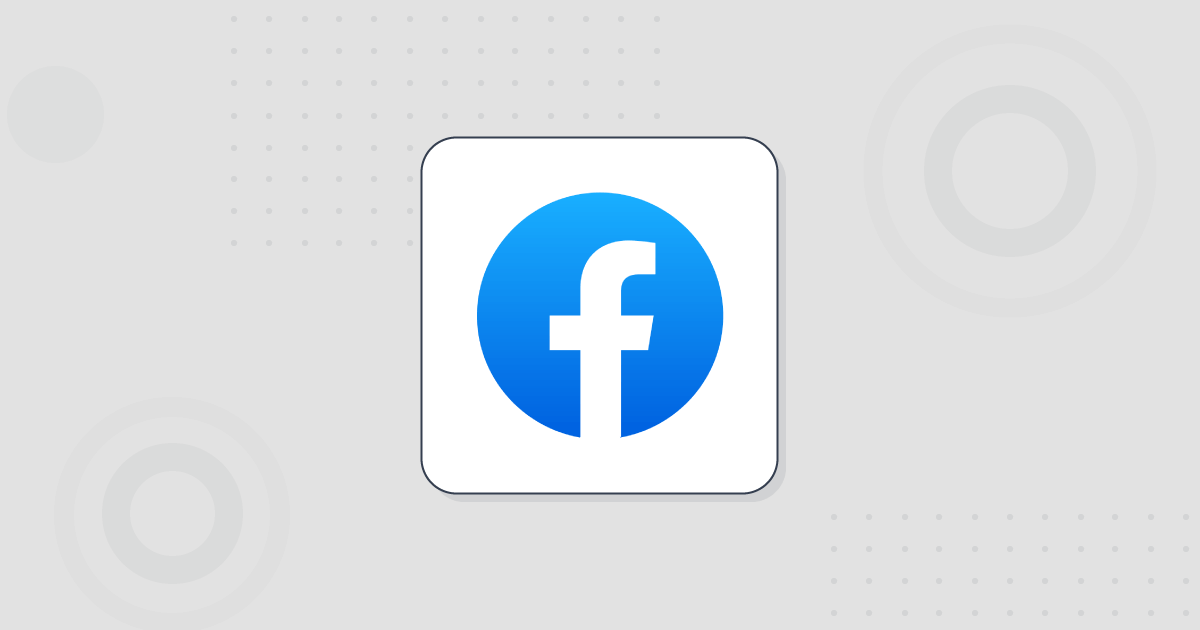
Facebook Marketing: Everything You Need To Know In 2024
Whether you have a brick-and-mortar store, an eCommerce site, or a blog, Facebook marketing gives you the power to nurture existing and potential customers and maximize conversions!
Here are some stats showing why Facebook marketing is an asset: Facebook takes over a quarter of all digital ad spending, behind Google (28.9%) and ahead of Amazon (10.3%). Moreover, according to Statista, it is the most widely used social media platform, counting approximately 2.93 billion monthly active users as of the first quarter of 2022.
In this guide, we’ve gathered valuable tips on building a successful Facebook marketing strategy for organic outreach and paid Facebook ads. Let’s kick off with the basics – setting up a Facebook Page!
How To Create A Facebook Business Page
Imagine that you’ve just started a small business and want to approach a new customer base on Facebook to boost brand awareness. Your first step is building a Facebook Page to host all the interactive content that will make consumers follow and ultimately love you.
Creating a Facebook Page is no rocket science, but you’ll need to spend some valuable time optimizing it for success. Here are some initial steps to follow:
- Find the “Pages” option on the left dropdown menu on your profile and select “Create New Page.”
 Complete the “Page name,” which is your company name, the category of your business – e.g., Restaurant – and a brief description of it for the “About” section.”Add a logo or a distinctive image as a “Profile Picture” around 180 x 180 pixels to maintain high quality.
Complete the “Page name,” which is your company name, the category of your business – e.g., Restaurant – and a brief description of it for the “About” section.”Add a logo or a distinctive image as a “Profile Picture” around 180 x 180 pixels to maintain high quality.- Then insert a complimentary “Cover Photo” that will give more info about your products/services to visitors and followers – the ideal size is 851 x 315 pixels. Here are Moosend’s assets as a reference:
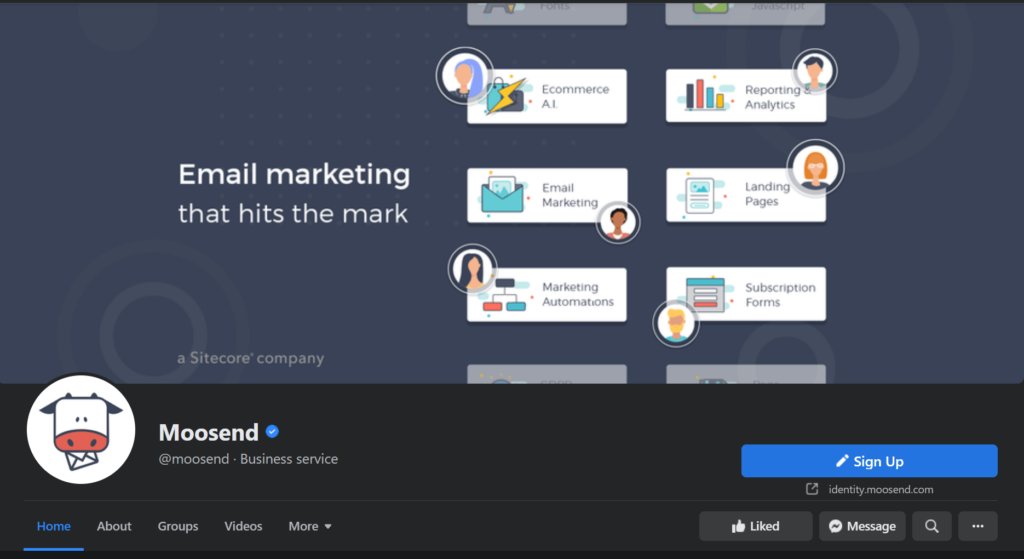
Optimize your Facebook Page
Now it’s time you gave more life to your Facebook Page:
- Go to the “About” section, and apart from the description, fill in your website, contact details, open hours, additional social channels, etc.
- Under your page name, you can find and edit the @username, your custom Facebook URL – also found as Vanity URL. This URL is unique for each business, it’s up to 50 characters, and helps visitors find you faster online.
- On the above image, you can find a sign-up button on the right. This way, you can prompt visitors to take a specific action to boost conversions by filling in the “Add A Button.” This call-to-action differs from business to business based on their objectives.
- If more than one people work on this platform, you can assign different roles based on their responsibilities. Apart from the admin that can manage all page aspects, you can include an editor, moderator, and analyst.
- If you want to increase the authority of your page, you can also request a verification badge from Facebook. This way, people who land on your website will trust you faster.
And just like that, your Facebook Page is ready to roll. Follow your brand guidelines when setting it up to enable visitors to get familiar with your brand assets faster!
How To Promote Your Facebook Page
With your Facebook Page up and running, it’s time to invite customers and prospects over to have a look.
Pro tip: before taking promotional actions, beautify your page and upload some Facebook posts your ideal customers can relate to so that they like your page without second thoughts.
Invite People Who Are Likely Interested
First off, you can rely on people who already know you or have heard of your business to support you. Go to the three dots on the right and choose “Invite Friends.” It’s best to stick with people interested in your products/services to avoid being spammy or irrelevant.
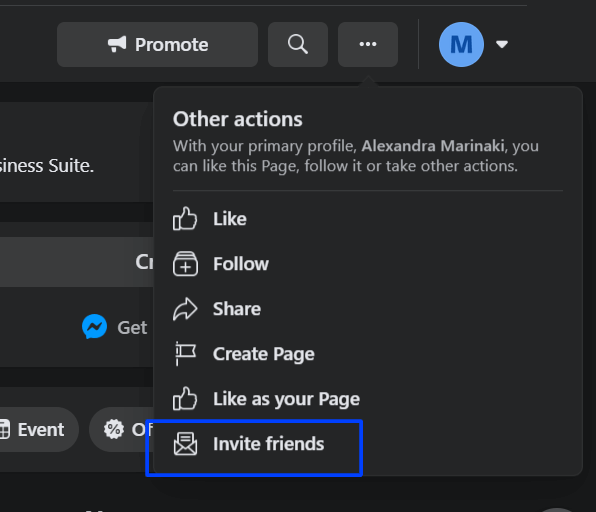
When you finish this initial outreach, encourage your colleagues and friends to follow the same process to build a social network like no other!
Add Facebook Buttons On Other Channels
To increase your lead generation on Facebook, you can cross-promote it on different channels you use to communicate with customers. For example, you can add social buttons to a prominent place on your website to enhance your social media marketing efforts.
If you have a blog or YouTube channel, feel free to share a Facebook button there, as well, to align your social with your content marketing practices. And, of course, cross-promote it on other social channels like LinkedIn or Instagram if you see fit.
You can also place a Facebook button on the email footer of your newsletters to attract the audience that already interacts with your brand. Here’s an example by Headspace to get inspired:
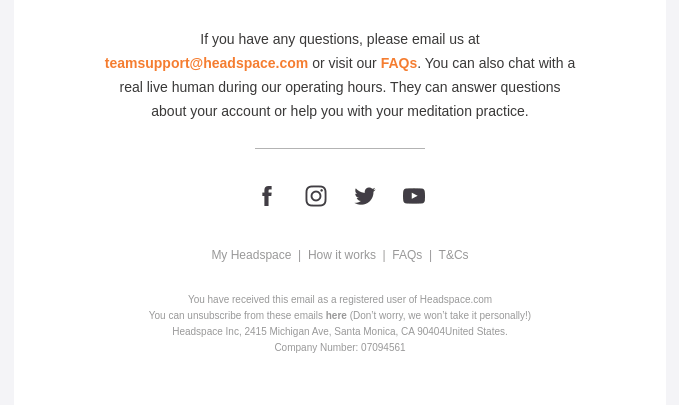
You can create these emails quickly using email marketing services like Moosend, offering intuitive drag-and-drop editors and personalization capabilities, among others.
Avoid Buying Likes
Many businesses are tempted to buy page likes to trick the Facebook algorithm and move things faster, but this practice hardly ever works.
You can never be 100% sure about where these likes come from. Fake accounts and unmotivated users can hardly generate high engagement rates, gradually leading to poor page performance. It’s not the likes that will bring new Facebook users to you, but your content and consumers’ buy-in.
In a nutshell, it’s best to choose a slower but safe pathway to Facebook promotion and grow a community with a genuine interest in you. The more you interact with them, the higher engagement you’ll receive over time!
Facebook Marketing Strategy: Tips For Success
You need a solid marketing plan to skyrocket your social media marketing game. Here’s how to streamline a successful Facebook marketing strategy:
1. Understand Your Target Audience
First and foremost, to deliver quality content to your audience, you should learn about them as much as you can. Forming the so-called buyer personas, which are the profiles of your top customers, will help you identify their content needs and upload relevant posts.
Apart from their demographics, such as age, gender, and education level, you can collect info about their purchase habits, interests, and motives. You can gather that information by conducting customer surveys or interviews – the more info, the better!
You can also reach out to your internal teams, such as sales, customer support, and product development, to give you more insights into what makes a loyal customer. Based on their remarks, you’ll be able to plan your Facebook content strategy and see what the future holds!
2. Set Smart Goals
Now that you’ve specified more details about your audience, it’s time you defined your exact Facebook marketing goals. These may change as your business and community grow, but to ensure that everything goes in the right direction, you should get as specific as possible.
For example, if you’ve just launched a Facebook Page for a new business, you can determine a target of page likes and followers you want to reach to boost awareness. On the other hand, if you run a large business, lead generation is more likely under your radar. Engagement rates, such as likes, shares, and CTR, have undoubtedly become a priority for you.
Finally, setting clear and measurable goals will let you take control of your strategy and revisit it regularly to alter it based on your general marketing objectives. Remember, social media management is an ongoing process, especially with the rapid changes occurring in the algorithm, and consumer habits and preferences.
3. Choose The Right Content For Your Audience
Knowing the inside out of your audience will help you find the best content for them. For example, a younger customer base would be likely keen on video posts, GIFs, and memes.
There are various types of content to choose from based on your audience’s needs and preferences. Here are some of them:
- Images: They can combine graphics and text, usually including a CTA.

- Facebook Stories: Short videos or images that last online for 24 hours.
- Link Posts: A post with a clickable link to generate traffic.
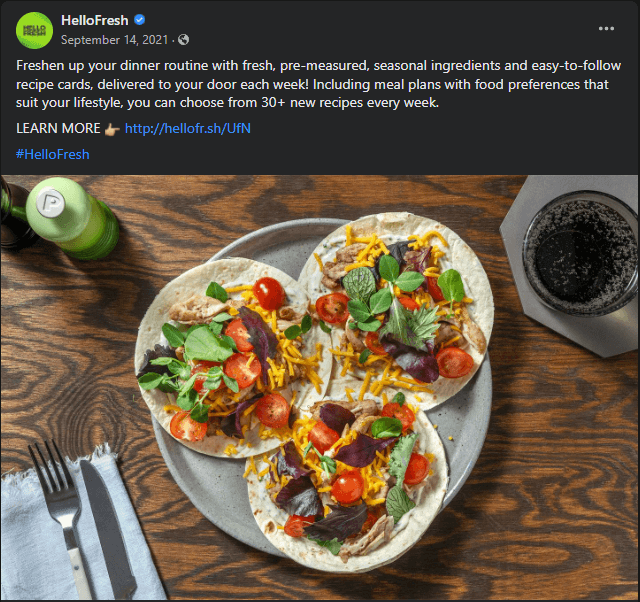
- Facebook Reels: Short, entertaining videos available to existing and new Facebook audiences.
- Videos: Prerecorded videos, with maximum performance when longer than 3-5 minutes.
- Facebook Live: Live videos which you can also upload as standalone videos after the streaming.
If you’re a Facebook marketing newbie, there’s a lot to experiment with, but remember to have fun in the process. You can also look at what other businesses with similar audiences and more experience post before you find your footing.
4. Build A Social Media Content Calendar
If you want to build a top-notch content strategy for your Facebook account, it’s important to keep track of what you post, including the type, date, and time. Just uploading content in your free time without minding your audience’s behavior and preferences won’t help you nurture the results you’ve been dreaming of.
On the other hand, a social media calendar will help you keep track of important information around content and identify patterns that work for your audience, such as best posting times. Add necessary info for all your social media, such as posting date and time, links to be included, creative assets, and copy.
Moreover, maintaining a consistent and frequent schedule will let your followers form expectations and engage with you more often.
5. Monitor Facebook Insights
You can’t build a successful strategy without looking into data that will help you improve your content and tactics down the road. Facebook Insights allows you to overview the most essential metrics.
Look at the board below to see some of that data:
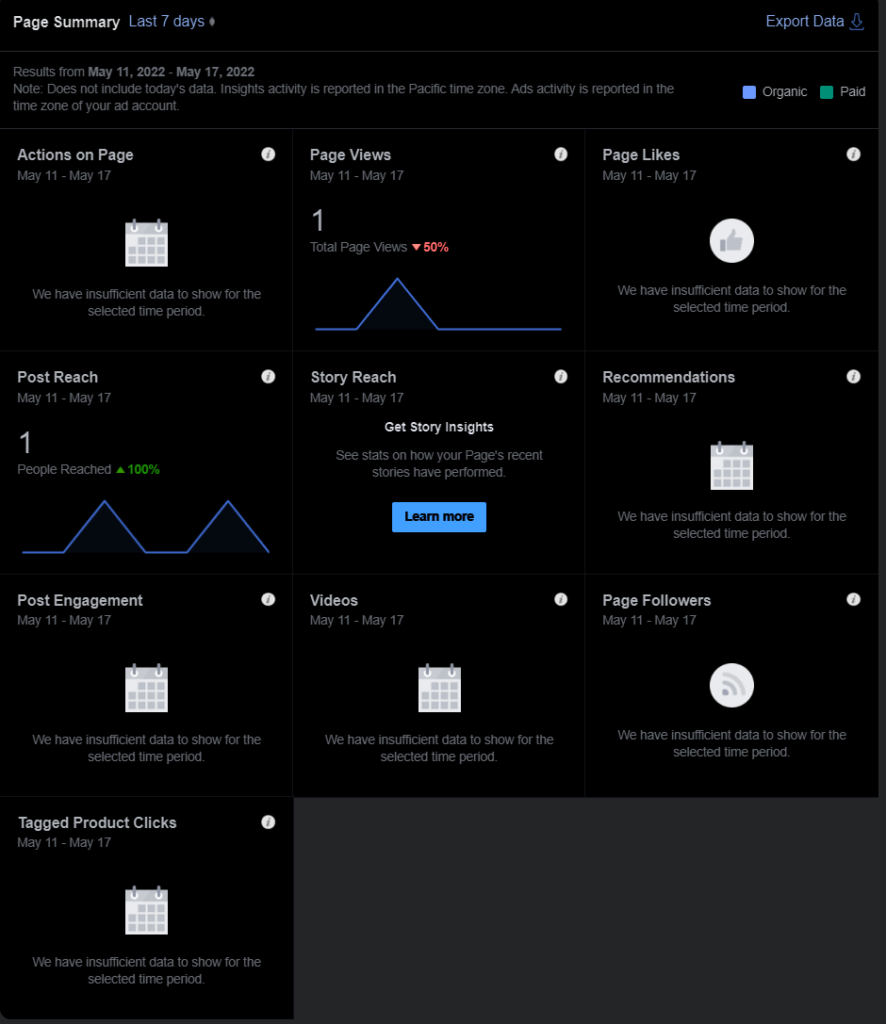
You can also monitor Audience Insights, found on Facebook Ad Manager, for more sophisticated data that will also enable you to revisit your buyer personas from time to time.
There, you’ll find insights regarding demographics – e.g., age, job title, relationship status, etc. – interests, hobbies, and lifestyles.
6. Try A Facebook Chatbot
A Facebook messenger marketing bot can help consumers get quick answers about products/services.. Even though it’s simple to respond to them through the Facebook app within a few minutes, it’s not always resourceful for your teams.
That’s where the Facebook bot steps in to save the day. Powered with AI, customers partake in an artificial conversation with the bot, which automatically answers some of the most common concerns. However, it’s best to give them the option to contact a representative for more complex matters that may occur.
How To Nail Organic Facebook Marketing
In this section, we’ll explore how to grow your Facebook channel organically to meet your marketing objectives. No matter if you work for a local business or a large corporation, these tips will prove to be valuable to you:
Optimize For SEO
Search engine optimization (SEO) is the bread and butter of an inbound digital marketing strategy, and you can apply its rules to your Facebook page, too.
The ultimate marketing tool you’ll need to practice is keyword research, allowing you to find the queries customers in your niche market look for. Let’s see some quick and easy tricks:
- Customize your page name: Consider adding a relevant keyword to your page name to increase the chances of ranking high.
- Optimize your vanity URL: Create an easy-to-spell domain name reflecting your brand.
- Rewrite your “About” section: Add relevant keywords to your business description to boost rankings.
- Share relevant content: Add relative terms to your captions and alternative text to appear higher on search results.
- Update contact details: This is mainly for physical stores to enable Facebook users to spot you faster.
For instance, we use Ahrefs to conduct keyword research. Here is what appears when typing “yoga studio:”

You can choose some of those keywords and sprinkle them smartly throughout your content when you complete this process!
Choose Optimal Posting Times
When do your followers visit Facebook more often? Is it on weekdays or weekends? Knowing when most of your customers hang out in their newsfeed will help you attract their attention faster and drive more clicks and conversions.
Before you start drawing data patterns from your fan base, you can make some initial assumptions based on their demographics, region, and behavior. For example, many people scroll through social media during their lunch break while others log in first thing in the morning.
And for those in need of a cheat sheet, here are some updated global Facebook engagement data by SproutSocial for maximum performance:
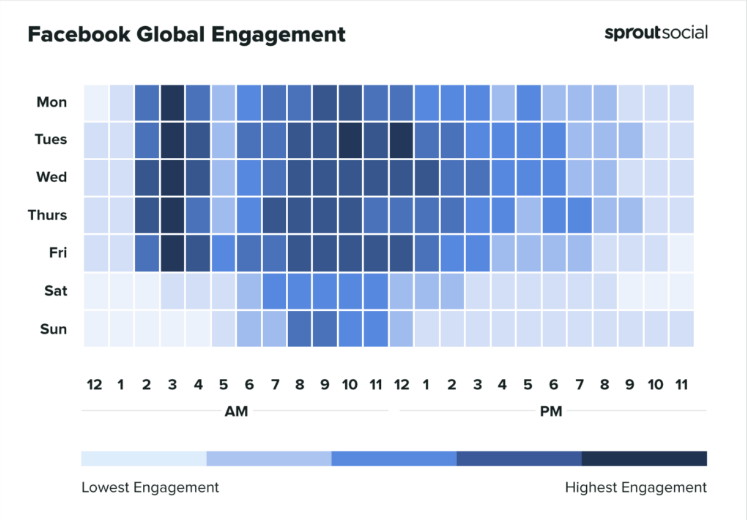
Get Your Employees Onboard
The Facebook algorithm favors content with high engagement rates, resulting from reactions, shares, and comments. But no matter how great your content is, it might be hard to claim them initially.
And that’s when your tribe can step in for support! Ask your colleagues to be the first who will react and comment on your posts to increase engagement. You can also invite them to share some of the significant content posts via email or your internal communication tool, including great copy they can share.
To get their buy-in, explain all the benefits your business can offer through these seemingly simple moves. Once your posts start to gain traction, new people will discover you, and if they’re interested in what you οffer, they will finally give you their golden page like.
Boost Lead Generation Activities
If you wish to gain more leads and start collecting valuable information, such as contact details, to move your visitors down the funnel, here are some content assets that will bring you conversions:
- Landing pages
- Sign-up forms
- Webinars and events
- Blog posts with high conversion rates
You can test different types of lead magnets from time to time to attract a diverse but highly converting audience and see what works best for them!
Plan a Giveaway
Who said that giveaways are solely for Instagram and Tiktok? You can also host a giveaway contest on Facebook to maximize your reach. In addition, you can increase your follower base, boost engagement and promote some of your unique products/services. Here’s how to do it successfully:
- Set a goal for your giveaway
- Select an attractive prize
- Define the giveaway entry rules (e.g., like the page, tag a friend)
- Fill out a form
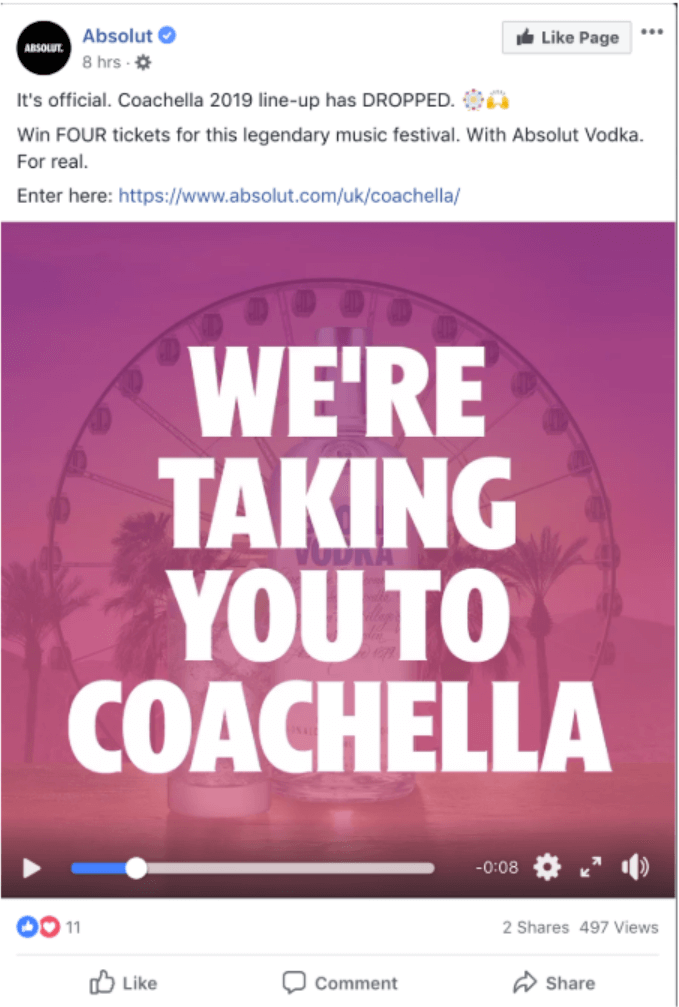
Apart from choosing an attractive prize for the winner, create a beautiful post with entertaining and clear copy, to avoid miscommunications with the contestants. And of course, wish them the best of luck!
Interact With Your Audience
To increase Facebook engagement, you need to start meaningful conversations with your audience. Always respond to comments, especially those addressing important questions, and show your customers and prospects that you care.
Moreover, always check Facebook Messenger and reply to all the messages you receive there. Consumers appreciate brands that are responsive to them so they’ll definitely stay around if your products/services and content resonate with them.
Overall, those interactions can also shed light on your customers’ biggest pain points or interests and may give a new perspective on how to improve your transactions with them in the future.
Build A Facebook Group
If you want your customers to feel like part of a community, you can create a Facebook Group where like-minded people interested in your brand and offers can enter.
In this digital place, you’ll be able to showcase your expertise and establish your authority among peers. To make this place more unique, offer special deals to members and show them that their loyalty matters to you!
Facebook Ads: Creating Highly Targeted Campaigns
Even though the value of organic reach is undeniable, sometimes you need to plan highly targeted marketing campaigns to meet your objectives. Facebook enables you to create ads giving you plenty of opportunities to reach the right audience for your business.
You can manage the whole advertising process through the Facebook Ad Manager dashboard. This process will require continuous testing until you find the most effective assets for your audience, but you’ll never go back once you gain a foothold!
Before we move to the nuts and bolts, let’s clarify the terms you should learn:
- Campaign: The “mother” of all assets
- Ad set: Different ad versions to target different audiences
- Ad: The unique ads resulting from your campaign setup
These are the essential steps for creating an effective Facebook:
1. Choose Your Marketing Objective
Once you’ve set up your business profile on Facebook Ad manager, you can start building your first campaign. The first step is to define your campaign objective. Choose between three main categories, awareness, consideration, and conversion, and their specific sub-goals:
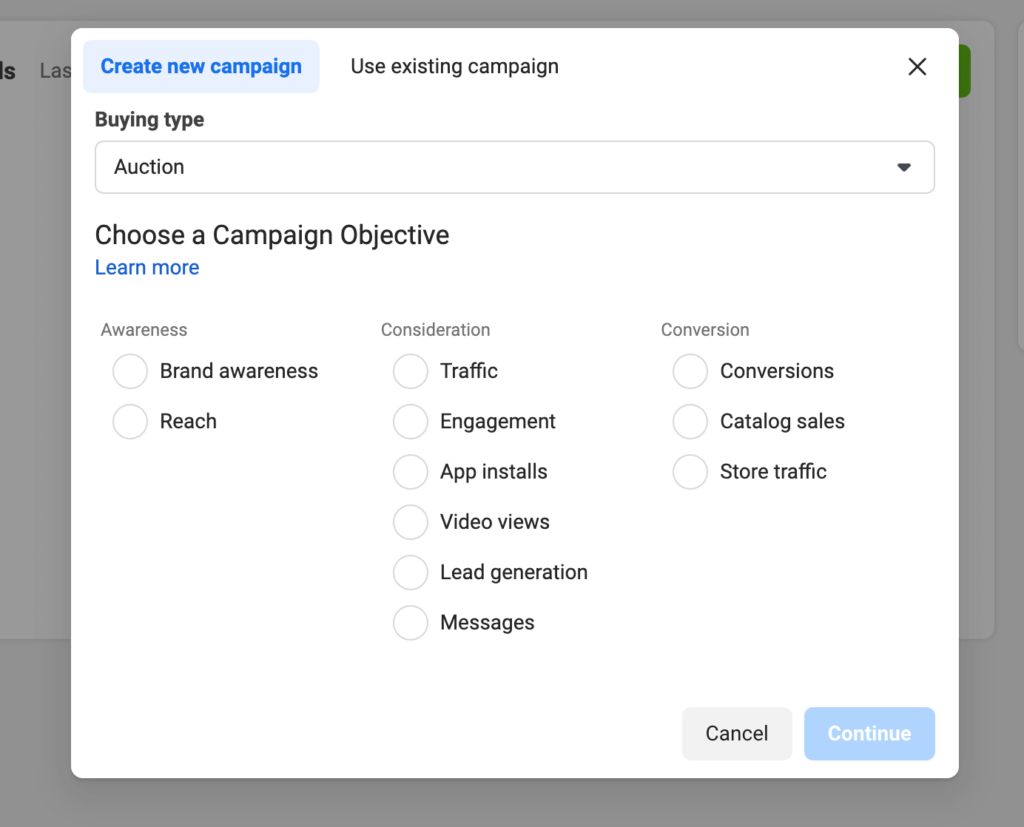
After picking your marketing objective, you can write your campaign name or create a template for future use. Before moving to the next step, Facebook requires you to specify whether your ads are related to credit, employment, housing, social, elections, or politics.
Moreover, you can choose if you want to A/B test different ad versions to find the most successful ones at this initial step.
2. Define Your Budget & Schedule
Once you’ve chosen the page you’d like to convert, e.g., your website or Facebook page, you can define your budget and schedule your ads. You have two main options:
Daily budget: Set the average amount you’d like to spend per day. This ad is going to run continuously.
Lifetime Budget: Your ad will run for a specific timeframe with this option. Facebook will evenly distribute your budget during the selected days.
A campaign budget optimization option also lets you distribute your budget across different ad sets based on a bidding strategy. Finally, when scheduling your ad, you can take the timezone of Facebook users into account for maximum results:
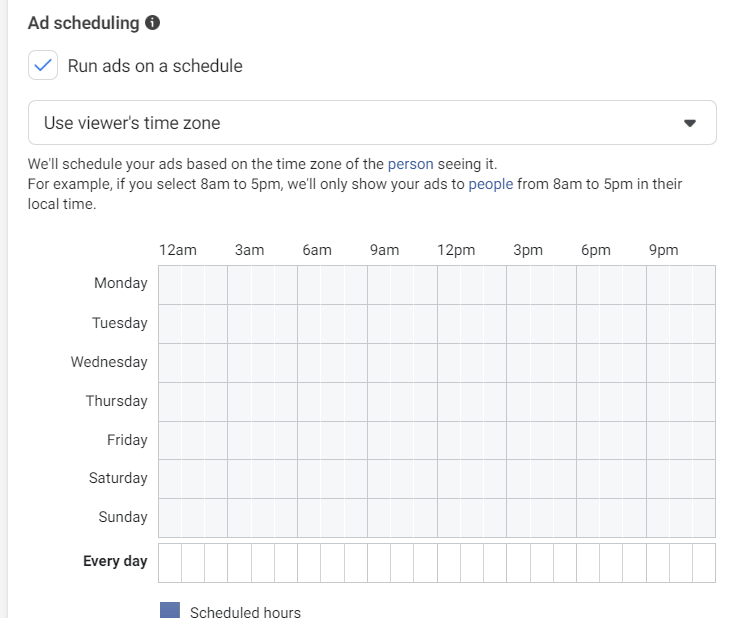
3. Determine Your Audience
Now, it’s time you selected the audiences you’d like to reach. You can specify demographic information such as age and gender and dive more deeply into your audience’s interests and behaviors. You can also save this audience for future advertising use.
Facebook also gives you the ability to find lookalike and custom audiences to bring better results. Moreover, through Facebook retargeting ads, you access consumers that have already visited your website to nurture them until they convert.
4. Select The Right Ad Format
There are many formats to choose from based on your customer’s needs to structure a successful ad. Let’s have a look:
Image: Ads with static images in PNG or JPG format. The recommended resolution is 1080×1080 and 600 pixels. As for the text and text line, the suggested characters are 125 and 25 respectively.
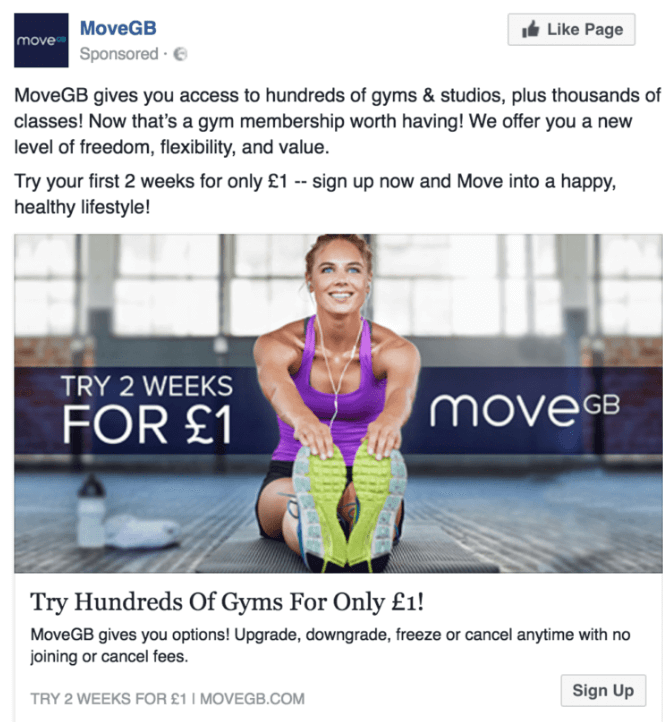
Videos: Video ads in MP4, MOV, or GIF, with at least 1080×1080 resolution. Video captions are recommended to make these assets accessible to everyone.
Carousel: A collection of images and/or videos to present various brand assets to current and prospective customers.
Collection: Up to five images that show up on mobile devices. It allows users to complete a purchase without leaving Facebook.
Moreover, you can choose the placement of your ads for maximum performance. If you’re still at the beginning, you can select “Automatic placements” and track the metrics closely for future reference.
5. Monitor The Ad Metrics
It’s impossible to form a successful Facebook advertising strategy without keeping a close eye on ad metrics. Here’s what to consider:
- Impressions
- Reach
- CTR (Click-through rate)
- CPC (Cost per click)
- Conversion rate
This set of data will help you analyze if your goals are met to determine whether you should alter your strategy. Keep in mind that no magic formula can apply to all businesses. Find out what works best for your target audience and change it when needed.
Take Facebook Marketing To The Next Level
Now that you’ve learned all the benefits and different opportunities from Facebook marketing, it gets tough to ignore it. If you don’t already have a Facebook page, build one asap and start promoting your brand to users that are highly likely to convert.
If your business is new, start with organic marketing techniques, and you can move on to paid ads as your business grows to maximize your reach. You can also run retargeting campaigns to find consumers that have already interacted with your brand.
Are you interested in building an omnichannel marketing experience? Sign up for a free trial with Moosend and promote your Facebook page to all your subscribers in simple steps. Just design a beautiful email footer with our drag-and-drop editor and bring them over to your Facebook page!



 Complete the “Page name,” which is your company name, the category of your business – e.g., Restaurant – and a brief description of it for the “About” section.”Add a logo or a distinctive image as a “Profile Picture” around 180 x 180 pixels to maintain high quality.
Complete the “Page name,” which is your company name, the category of your business – e.g., Restaurant – and a brief description of it for the “About” section.”Add a logo or a distinctive image as a “Profile Picture” around 180 x 180 pixels to maintain high quality.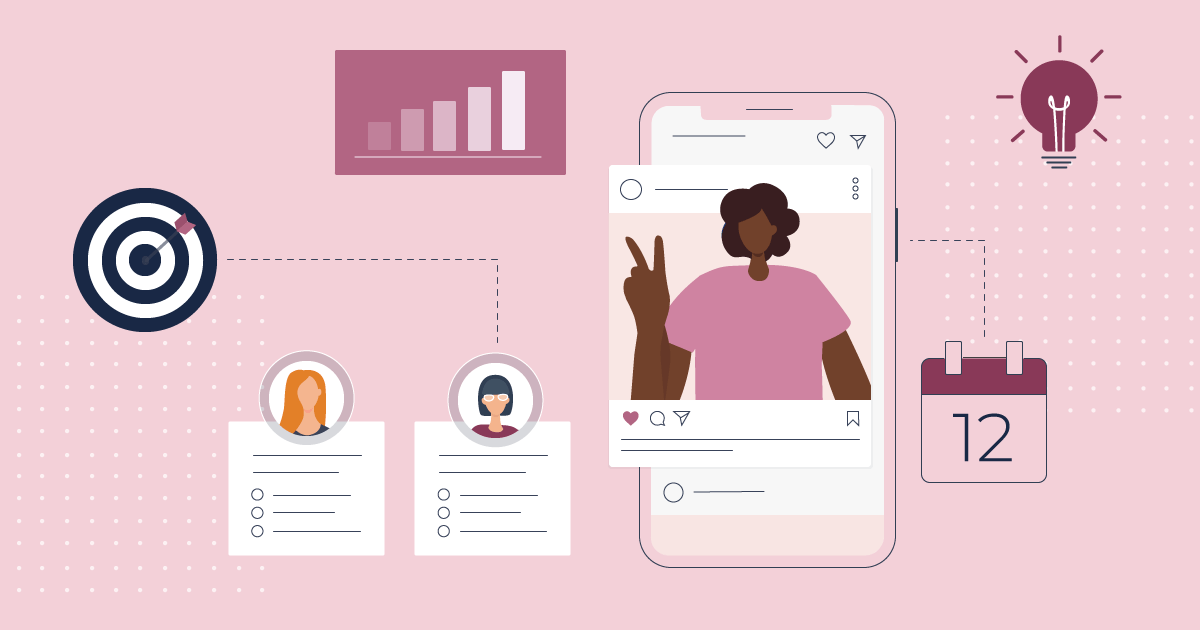

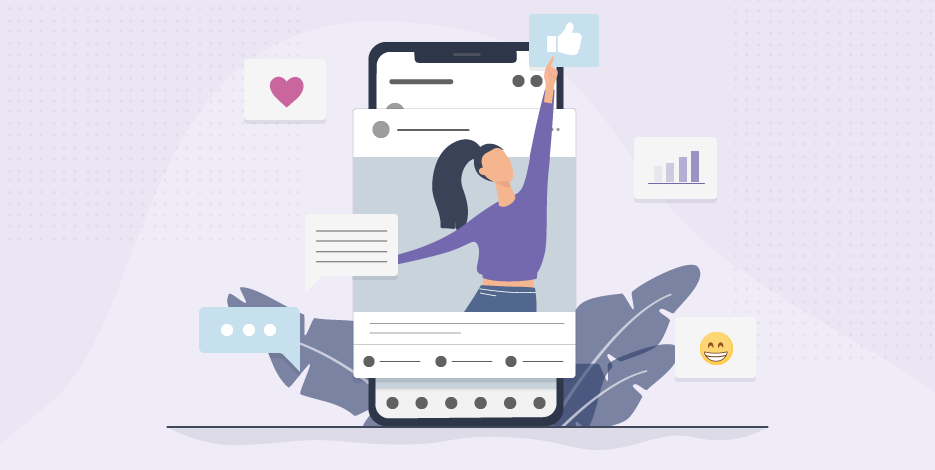
 Published by
Published by